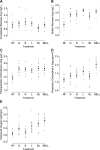Ecological and evolutionary effects of stickleback on community structure
- PMID: 23573203
- PMCID: PMC3616105
- DOI: 10.1371/journal.pone.0059644
Ecological and evolutionary effects of stickleback on community structure
Abstract
Species' ecology and evolution can have strong effects on communities. Both may change concurrently when species colonize a new ecosystem. We know little, however, about the combined effects of ecological and evolutionary change on community structure. We simultaneously examined the effects of top-predator ecology and evolution on freshwater community parameters using recently evolved generalist and specialist ecotypes of three-spine stickleback (Gasterosteus aculeatus). We used a mesocosm experiment to directly examine the effects of ecological (fish presence and density) and evolutionary (phenotypic diversity and specialization) factors on community structure at lower trophic levels. We evaluated zooplankton biomass and composition, periphyton and phytoplankton chlorophyll-a concentration, and net primary production among treatments containing different densities and diversities of stickleback. Our results showed that both ecological and evolutionary differences in the top-predator affect different aspects of community structure and composition. Community structure, specifically the abundance of organisms at each trophic level, was affected by stickleback presence and density, whereas composition of zooplankton was influenced by stickleback diversity and specialization. Primary productivity, in terms of chlorophyll-a concentration and net primary production was affected by ecological but not evolutionary factors. Our results stress the importance of concurrently evaluating both changes in density and phenotypic diversity on the structure and composition of communities.
Conflict of interest statement
Figures


Similar articles
-
Adaptive genetic variation mediates bottom-up and top-down control in an aquatic ecosystem.Proc Biol Sci. 2015 Aug 7;282(1812):20151234. doi: 10.1098/rspb.2015.1234. Proc Biol Sci. 2015. PMID: 26203004 Free PMC article.
-
Short-term fish predation destroys resilience of zooplankton communities and prevents recovery of phytoplankton control by zooplankton grazing.PLoS One. 2019 Feb 15;14(2):e0212351. doi: 10.1371/journal.pone.0212351. eCollection 2019. PLoS One. 2019. PMID: 30768619 Free PMC article.
-
Evolutionary diversification in stickleback affects ecosystem functioning.Nature. 2009 Apr 30;458(7242):1167-70. doi: 10.1038/nature07974. Epub 2009 Apr 1. Nature. 2009. PMID: 19339968
-
Nine-spined stickleback (Pungitius pungitius): an emerging model for evolutionary biology research.Ann N Y Acad Sci. 2013 Jun;1289:18-35. doi: 10.1111/nyas.12089. Epub 2013 Mar 29. Ann N Y Acad Sci. 2013. PMID: 23550583 Review.
-
The interaction between cyanobacteria and zooplankton in a more eutrophic world.Harmful Algae. 2016 Apr;54:128-144. doi: 10.1016/j.hal.2015.12.005. Harmful Algae. 2016. PMID: 28073472 Review.
Cited by
-
Parallel changes in gut microbiome composition and function during colonization, local adaptation and ecological speciation.Proc Biol Sci. 2019 Dec 4;286(1916):20191911. doi: 10.1098/rspb.2019.1911. Epub 2019 Dec 4. Proc Biol Sci. 2019. PMID: 31795865 Free PMC article.
-
Mechanisms behind bottom-up effects: eutrophication increases fecundity by shortening the interspawning interval in stickleback.PeerJ. 2020 Jul 17;8:e9521. doi: 10.7717/peerj.9521. eCollection 2020. PeerJ. 2020. PMID: 32742798 Free PMC article.
-
Ecological speciation in a generalist consumer expands the trophic niche of a dominant predator.Sci Rep. 2017 Aug 18;7(1):8765. doi: 10.1038/s41598-017-08263-9. Sci Rep. 2017. PMID: 28821736 Free PMC article.
-
Variability of functional traits and their syndromes in a freshwater fish species (Phoxinus phoxinus): The role of adaptive and nonadaptive processes.Ecol Evol. 2019 Feb 14;9(5):2833-2846. doi: 10.1002/ece3.4961. eCollection 2019 Mar. Ecol Evol. 2019. PMID: 30891220 Free PMC article.
-
An experimental test of eco-evolutionary dynamics on rocky shores.Ecology. 2025 Jan;106(1):e4505. doi: 10.1002/ecy.4505. Ecology. 2025. PMID: 39814598 Free PMC article.
References
-
- Cardinale BJ, Srivastava DS, Duffy JE, Wright JP, Downing AL, et al. (2006) Effects of biodiversity on the functioning of trophic groups and ecosystems. Nature 443: 989–992. - PubMed
-
- Harmon LJ, Matthews B, Des Roches S, Chase JM, Shurin JB, et al. (2009) Evolutionary diversification in stickleback affects ecosystem functioning. Nature 458: 1167–1170. - PubMed
-
- Hooper DU, Chapin FS, Ewel JJ, Hector A, Inchausti P, et al. (2005) Effects of biodiversity on ecosystem functioning: A consensus of current knowledge. Ecological Monographs 75: 3–35.
-
- Loreau M, Naeem S, Inchausti P, Bengtsson J, Grime JP, et al. (2001) Ecology - Biodiversity and ecosystem functioning: Current knowledge and future challenges. Science 294: 804–808. - PubMed
Publication types
MeSH terms
LinkOut - more resources
Full Text Sources
Other Literature Sources

